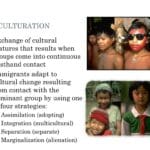Embark on a journey into the fascinating world of acculturation, the process of cultural exchange and adaptation that occurs when different cultures come into contact. This guide delves into the heart of AP Human Geography to uncover how individuals and communities navigate new cultural settings, adapt their behaviors, and shape their identities in a globalized world.
Acculturation in AP Human Geography
Acculturation, a cornerstone concept in AP Human Geography, refers to the intricate process of cultural blending and adaptation that transpires when individuals or groups from diverse cultural backgrounds interact over an extended period. Imagine a vibrant tapestry woven from threads of various cultures—that’s acculturation!
Picture this: you relocate to a new country. While you likely wouldn’t abandon your cherished customs entirely, you’d probably find yourself embracing new traditions, perhaps picking up the local language or exploring the local cuisine. This dynamic interplay, where both the newcomer and the existing culture undergo subtle transformations, exemplifies acculturation in action.
However, acculturation isn’t always a seamless journey. Many individuals encounter culture shock—feelings of disorientation and discomfort—as they grapple with unfamiliar customs and languages. This experience, while challenging, presents a unique opportunity for personal growth and a broadened worldview.
Different perspectives exist regarding the dynamics of acculturation. Some scholars liken it to a melting pot, where cultures blend seamlessly, while others envision it as a salad bowl, where each culture retains its distinct flavor while contributing to a larger whole.
Acculturation manifests in countless ways, from immigrants carrying their traditions to new lands to students mastering foreign languages. It’s a ubiquitous process that shapes our interconnected world.
So, why is acculturation so crucial in AP Human Geography? It’s a lens through which we can understand cultural interactions, global migration patterns, and the evolving cultural landscape shaped by globalization. It underscores the interconnectedness of our world and the rich tapestry of cultures that make it so captivating.
What Does Acculturation Mean in AP Human Geography?
In the realm of AP Human Geography, acculturation boils down to the gradual adoption of cultural elements from one group to another through sustained contact. Think of it as a cultural exchange, where individuals and societies borrow and adapt customs, languages, and even styles of dress from each other. For instance, the global diffusion of American fast food chains or the widespread popularity of certain music genres exemplifies how cultural elements can permeate and reshape societies over time.
It’s crucial to note that acculturation is not a one-sided affair. It’s a reciprocal process—a cultural give-and-take—where both cultures involved undergo transformations. This blending can lead to the emergence of entirely new cultural patterns and identities.
Here’s a concise table summarizing key aspects of acculturation:
| Feature | Description |
|---|---|
| Definition | The process of adopting cultural traits from another group. |
| Cause | Prolonged contact and interaction between different cultural groups. |
| Scale | Can affect individuals and entire societies. |
| Outcomes | Adoption of new cultural practices, values, beliefs, and the formation of new identities. |
| Complexity | Dynamic and ongoing process, often with unpredictable results. |
Researchers continue to delve into the multifaceted nature of acculturation, examining its implications for various aspects of human societies, from economic development to social relationships. While a fundamental understanding of acculturation exists, there’s still much to uncover about this captivating process. It serves as a potent reminder that cultures are not static entities but rather constantly evolving, shaped by the ebb and flow of human interaction.
What Is an Example of Acculturation in Geography?
To truly grasp the essence of acculturation, let’s consider a real-world example: Mexican immigrants in the United States. Many have embraced English as their primary language and observe American holidays like Thanksgiving. Simultaneously, they might continue to converse in Spanish within their families and savor traditional Mexican dishes, preserving a vital link to their heritage.
This example highlights the nuanced nature of acculturation, where individuals often blend elements of their original culture with those of their adopted culture, creating a unique cultural hybridity.
Here are a few more compelling examples of acculturation in action across the globe:
- Fashion Fusion: In many parts of Africa, individuals seamlessly blend Western-style clothing and hairstyles with traditional wardrobes, resulting in a captivating fusion of old and new.
- Religious Influence: The spread of Islam in Southeast Asia stands as a testament to the profound influence religions can wield, reshaping cultural landscapes over generations.
- Pop Culture Powerhouse: American pop culture, with its pervasive music, movies, and fashion trends, has left an indelible mark on young people worldwide, leading to the adoption of American slang, music preferences, and even social values in numerous corners of the globe.
It’s essential to recognize that acculturation, while often enriching, is not without its challenges. While it can foster cultural exchange and create exciting new cultural expressions, it can also give rise to cultural clashes, misunderstandings, and even the erosion of traditional practices. Some experts suggest that certain groups might feel pressured to conform to dominant cultural norms, potentially jeopardizing their own cultural identity. Conversely, acculturation is a two-way street, with the dominant culture also absorbing influences from the cultures it encounters. Acculturation remains a complex issue, and ongoing research continues to shed light on its multifaceted nature and its impact on societies worldwide.
What Is the Difference Between Assimilation and Acculturation in Human Geography?
In discussions about cultural exchange, two terms frequently arise: acculturation and assimilation. While often used interchangeably, these terms represent distinct concepts in how cultures blend (or don’t).
Consider this analogy: you’re learning to cook in a new country. Acculturation is akin to incorporating your favorite spices from your homeland into a traditional dish from your adopted country. You’re blending flavors, experimenting with new tastes while preserving a hint of your culinary heritage.
Assimilation, conversely, is like discarding your spice rack entirely and embracing only the flavors of your new culinary landscape. It signifies a more complete transformation, and while you might master the local cuisine, the unique flavors of your own background might fade away.
To clarify further, here’s a comparison table:
| Feature | Acculturation | Assimilation |
|---|---|---|
| Direction | Two-way: both cultures influence each other | One-way: minority culture adopts majority traits |
| Cultural Change | Blending and adapting | Replacing original culture with dominant one |
| Identity | Retains original cultural identity | May lead to loss of original cultural identity |
| Outcome | Cultural diversity and hybridity | Cultural homogeneity |
It’s worth noting that acculturation can present its share of challenges. Individuals navigating this process might experience a sense of being caught between two worlds, grappling with uncertainty about which traditions to follow. They might even encounter prejudice from both their original and new communities.
Assimilation, while seemingly straightforward, also carries complexities. The pressure to conform to the dominant culture can be immense, potentially leading individuals to relinquish their cultural heritage in their pursuit of acceptance. This can result in feelings of loss, identity confusion, and even friction within families who experience varying degrees of assimilation.
The key takeaway is that neither acculturation nor assimilation is inherently positive or negative. They are processes that naturally occur when cultures interact, and they manifest differently for each individual and community. Grasping these concepts enables us to view the world through a more empathetic lens and appreciate the intricate tapestry of cultures that enrich our global society.
Researchers continue to investigate the complexities of acculturation and assimilation, especially in our increasingly interconnected world. Questions about the influence of globalization and technology on these processes, as well as the factors that facilitate smoother cultural integration, continue to intrigue geographers and social scientists.
What Is an Example of Assimilation in AP Human Geography?
Let’s delve into a real-world scenario that exemplifies assimilation within the context of AP Human Geography: Mexican immigrants in the United States.
Over time, some Mexican immigrants might find themselves speaking English more frequently than Spanish. They may also begin to observe American holidays like Thanksgiving and Independence Day while participating less in traditional Mexican festivities. This gradual shift, where elements of their original culture become less pronounced, reflects assimilation. Their cultural practices gradually align with those of the dominant American culture.
While this process might appear simple on the surface, it encompasses deeper complexities. It’s not merely about language or holidays; it can also involve shifts in values, beliefs, and even worldviews. Some experts suggest that economic opportunities and societal pressures can contribute to assimilation. Others argue that it’s not always a one-sided process, as elements of the less dominant culture can influence the dominant one, culminating in a more interwoven cultural landscape.
It’s crucial to acknowledge the potential drawbacks of complete assimilation. As a less dominant culture becomes increasingly similar to the dominant one, its unique traditions and practices risk being overshadowed, potentially leading to a decline in cultural diversity. Imagine a world where everyone adhered to the same customs, consumed the same foods, and celebrated the same holidays—it would lack the richness and vibrancy that diversity brings.
The case of Mexican immigrants in the US serves as a valuable illustration of assimilation as a multifaceted process with potential advantages and disadvantages. It underscores the dynamic essence of culture and the ongoing interactions between diverse cultural groups. However, it’s important to note that this is just one example among many, and numerous other captivating instances of assimilation from around the world offer unique insights into this complex phenomenon.
How Do You Explain Acculturation?
Acculturation encompasses the fascinating ways in which individuals and groups adapt to new cultural settings while retaining elements of their own cultural heritage. It’s a process of cultural exchange and adaptation, where people adopt new customs, beliefs, and behaviors while holding onto cherished aspects of their own backgrounds.
This process can be likened to a cultural mosaic, where individuals and societies piece together elements from different cultures to create something unique and multifaceted. It’s not about erasing one’s cultural identity but rather about finding ways to navigate and integrate into a new cultural landscape while preserving a sense of self.
Several factors influence how acculturation unfolds, including individual characteristics, social dynamics, and the relationships between different cultures. For example, individuals who feel welcomed and supported in their new environment might find it easier to adapt and embrace new cultural elements. Conversely, those who experience discrimination or prejudice might be more inclined to hold onto their own cultural traditions.
Here are some key points to remember about acculturation:
- Acculturation is a cultural blend: Individuals and groups adopt elements from different cultures, creating a unique cultural mix.
- It’s a process of adaptation, not replacement: Acculturation involves finding ways to live in multiple cultural worlds without losing one’s sense of identity.
- It’s a gradual process: Adapting to and integrating into a new cultural environment takes time and effort.
- Everyone’s experience is unique: There’s no right or wrong way to experience acculturation, as it’s influenced by a combination of personal, social, and cultural factors.
- It’s a two-way street: Acculturation involves both individuals adapting to a new culture and societies adjusting to accommodate new cultural influences.
Researchers are continually working to deepen our understanding of acculturation. They explore the psychological and social impacts of navigating multiple cultural identities, the role of language and communication in cultural adaptation, and the factors that contribute to successful integration.
By gaining a deeper understanding of acculturation, we can foster more inclusive and welcoming societies that value and celebrate cultural diversity, recognizing that our differences are what make our world so rich and vibrant.
What are the 4 Types of Acculturation Examples?
Adapting to a new culture is a multifaceted experience, and individuals approach this process in various ways. Let’s explore four common types of acculturation:
1. Assimilation: Embracing the New
Assimilation involves fully embracing the new culture while gradually relinquishing ties to one’s original cultural practices. Imagine someone moving to a new country and immersing themselves in the local language, customs, and values, eventually resembling someone born and raised in that culture.
2. Integration: Finding Harmony
Integration involves striking a balance between adopting aspects of the new culture and preserving elements of one’s own cultural heritage. It’s about navigating both worlds comfortably, embracing new customs while staying true to one’s roots. Think of someone who learns the local language but still speaks their native tongue at home or celebrates both traditional and new holidays.
3. Separation: Maintaining Distance
Separation occurs when individuals or groups choose to maintain a degree of separation from the dominant culture, preserving their own customs and traditions. This might involve living in ethnic enclaves, primarily interacting with members of their own cultural group, and resisting significant cultural adaptations.
4. Marginalization: Navigating Exclusion
Marginalization represents a less ideal outcome, where individuals or groups experience exclusion or marginalization from both their original and the new culture. This can occur due to discrimination, prejudice, or a lack of access to opportunities, leading to feelings of isolation, lack of belonging, and difficulty integrating.
Important Considerations:
- It’s crucial to remember that acculturation is not a linear process with fixed categories. Individuals might experience different types of acculturation at different points in their lives or even simultaneously.
- Our understanding of acculturation is always evolving as researchers continue to explore its complexities and nuances.
- Each type of acculturation has its own set of challenges and opportunities, and none is inherently superior or inferior.
By understanding these different approaches to acculturation, we can foster a greater appreciation for the diverse ways in which individuals and groups navigate cultural transitions. It allows us to view cultural diversity as a strength, recognizing the unique contributions of each cultural group while promoting understanding and respect for all.
What Is the Difference Between Acculturation and Enculturation?
While both enculturation and acculturation shape our cultural understanding, they operate in distinct ways.
Enculturation: Absorbing Your Own Culture
Enculturation is the process of learning and internalizing the values, beliefs, and practices of your own culture. It’s a lifelong process that begins at birth and continues throughout our lives. We learn about our culture through family, friends, education, religious institutions, and the media. It shapes our identity and sense of belonging within our cultural group.
- Analogy: Think of a sponge absorbing water; enculturation is the natural process of learning and internalizing your native culture.
Acculturation: Adapting to a New Culture
Acculturation, on the other hand, occurs when we come into contact with a new culture and begin to adapt our behaviors and beliefs accordingly. This often happens when people move to a new country, interact with people from different cultural backgrounds, or experience cultural exchange through travel or media.
- Analogy: Imagine adding new ingredients to a recipe; acculturation is blending your existing cultural traits with elements of a new culture.
Here’s a table summarizing the key differences:
| Term | Description |
|---|---|
| Enculturation | Learning your own culture from childhood. |
| Acculturation | Adapting to a new culture while retaining aspects of your own. |
Key Points to Remember:
- Enculturation is a passive process, while acculturation is more active and involves conscious effort.
- Acculturation is a two-way process, meaning that both the individual and the new culture are changed through interaction.
- The degree to which individuals acculturate varies depending on many factors, such as their personality, age, language proficiency, and the level of acceptance and support they receive from the new culture.
Understanding the difference between enculturation and acculturation is crucial for appreciating cultural diversity and navigating intercultural interactions effectively. It allows us to recognize the influence of both our own cultural upbringing and our experiences with other cultures on our values, beliefs, and behaviors.
What Is the Difference Between Acculturation and Appropriation?
Acculturation and appropriation often get confused, but understanding their distinct meanings is crucial for respectful cultural exchange.
Acculturation: Reciprocal Exchange
As we’ve discussed, acculturation involves the blending of cultures through a two-way exchange of customs, traditions, and ideas. It’s a process of mutual influence and adaptation, where individuals and groups adopt elements from other cultures while retaining aspects of their own.
Appropriation: Taking Without Respect
Cultural appropriation, however, occurs when elements of one culture are adopted by members of another culture without proper understanding, respect, or acknowledgment of their origins. It often involves taking cultural elements out of context, reducing them to stereotypes, or using them for personal gain without permission or attribution.
Here’s a closer look at the differences:
| Feature | Acculturation | Appropriation |
|---|---|---|
| Nature | Mutual exchange and adaptation | Unilateral taking and often misrepresentation |
| Respect | Demonstrates appreciation and understanding | Lacks respect for cultural significance |
| Power Dynamics | Acknowledges power imbalances between cultures | Often perpetuates power imbalances |
| Impact | Enriches cultural diversity | Can lead to cultural insensitivity and harm |
Examples:
- Acculturation: Learning a new language to communicate more effectively with people from a different cultural background.
- Appropriation: Using a sacred symbol from another culture as a fashion accessory or decorative element without understanding its meaning or significance.
Avoiding Appropriation:
- Educate yourself about the culture you’re engaging with.
- Seek permission and guidance from members of that culture.
- Be mindful of power dynamics and potential harm.
- Give credit and acknowledge the origins of cultural elements.
- Support and amplify the voices of marginalized cultures.
Promoting genuine cultural exchange requires understanding and respecting the boundaries between acculturation and appropriation. By engaging in thoughtful and respectful cross-cultural interactions, we can celebrate cultural diversity while avoiding harmful stereotypes and ensuring that cultural exchange remains a positive and enriching experience for all involved.
What Is the Meaning of Acculturation Factors?
Acculturation, the process of adapting to a new culture, is influenced by a range of factors that shape how individuals and groups navigate cultural transitions. These factors can either facilitate or hinder the integration process, making it essential to understand their impact.
Personal Factors
- Age: Younger individuals tend to adapt to new cultural environments more easily than older individuals.
- Education: Higher education levels can provide the knowledge, skills, and confidence to navigate cultural differences.
- Motivation: Individuals who are motivated to integrate are more likely to embrace new cultural elements.
- Personality: Openness to experience, extroversion, and cultural empathy can facilitate acculturation.
Social Factors
- Acceptance: Feeling welcomed and included by the host society fosters a sense of belonging and encourages acculturation.
- Support Systems: Strong social networks, including family, friends, and cultural organizations, provide support and guidance during cultural transitions.
- Social Networks: Interacting with individuals from both the original and new cultures exposes individuals to different perspectives and facilitates adaptation.
Cultural Factors
- Similarities: Shared values, beliefs, and practices between cultures can ease the acculturation process.
- Differences: Significant cultural differences can pose challenges to adaptation, requiring greater effort to bridge the cultural gap.
Impact on Acculturation Outcomes
The interplay of these factors influences the acculturation strategies individuals adopt, leading to different outcomes:
- Assimilation: Occurs when individuals adopt the dominant culture fully and relinquish their original cultural identity.
- Integration: Involves embracing aspects of both the original and new cultures, leading to a blended cultural identity.
- Separation: Occurs when individuals maintain their original culture and resist adopting elements of the new culture.
- Marginalization: Represents a lack of integration into both the original and new cultures, resulting in social exclusion.
Understanding Acculturation Factors: Promoting Inclusivity
By recognizing the diverse factors that shape acculturation, we can foster more inclusive and welcoming societies that support individuals and groups in navigating cultural transitions. This understanding is essential for promoting cross-cultural communication, reducing prejudice and discrimination, and creating communities where everyone feels valued and respected.
What Is an Example of Acculturation Quizlet?
Imagine a scenario where a family migrates from a rural village in India to a bustling city in the United States. They might gradually start incorporating English words into their daily conversations, exploring American cuisine at local restaurants, and even adopting certain American customs, like celebrating Thanksgiving. However, they might also continue to speak their native language at home, cook traditional Indian dishes, and observe their cultural and religious practices.
This scenario exemplifies acculturation – the gradual adaptation to a new culture while preserving elements of one’s own. It highlights how individuals and groups selectively adopt and adapt to new cultural elements while retaining their unique cultural identities.
This example underscores the dynamic and complex nature of acculturation, emphasizing that it’s not a linear process but a multifaceted journey of cultural exchange and adaptation.
Key Takeaways from this Example:
- Acculturation involves a blend of adopting new customs and preserving existing ones.
- It’s a gradual process, with individuals and groups choosing which elements to embrace and which to retain.
- Acculturation results in a hybrid cultural identity, reflecting influences from both the original and adopted cultures.
Remember: This is just one example, and countless others illustrate the diverse ways in which acculturation plays out worldwide.
By studying these real-life instances, we gain valuable insights into the complexities of cultural exchange, adaptation, and the ever-evolving nature of cultural identity in our increasingly interconnected world.
Conclusion: Appreciating Cultural Diversity Through the Lens of Acculturation
This in-depth exploration of acculturation in AP Human Geography has illuminated the intricate ways in which cultures interact, adapt, and shape our world. From understanding the nuances of assimilation and appropriation to recognizing the factors that influence cultural adaptation, we’ve gained valuable insights into this complex and ever-evolving process.
As our world becomes increasingly interconnected, grasping the dynamics of acculturation becomes essential for fostering inclusivity, bridging cultural divides, and appreciating the rich tapestry of cultures that make our world so vibrant. By approaching cultural exchange with sensitivity, respect, and a willingness to learn, we can create a more harmonious and enriching global community.
For further exploration of related concepts, consider delving into the intriguing topic of ethnocentrism in AP Human Geography.
- Crypto Quotes’ Red Flags: Avoid Costly Mistakes - June 30, 2025
- Unlock Inspirational Crypto Quotes: Future Predictions - June 30, 2025
- Famous Bitcoin Quotes: A Deep Dive into Crypto’s History - June 30, 2025

















1 thought on “Navigating Cultural Waters: An Exploration of Acculturation in AP Human Geography”
Comments are closed.